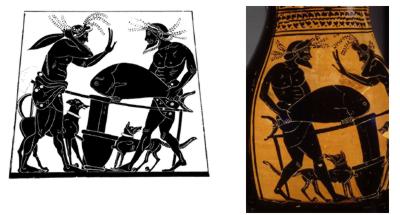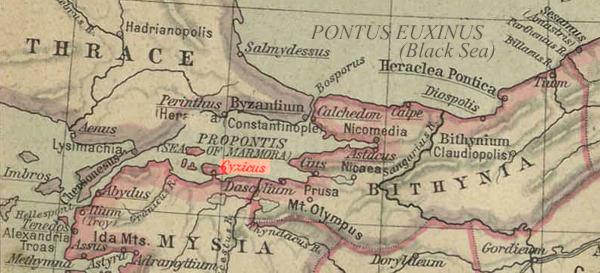History of tuna fishing
One of the most interesting facts about the tunas is that these fish
have been important to the life of man from the earliest times. The
ancient peoples of the Mediterranean prized the tuna immensely. From the
strait of Gibraltar in the west to the Black Sea in the East, this fish
was hunted and consumed in earnest. Greeks from the classical period
onward were crazy about fish. Among the thousands of fish which the
Greeks harvested, bluefin tuna was the most valuable and considered
superior to all other fish, due to bluefin's awesome size and the
extraordinary quality of its meat.
The ancients, delighted with its taste, wrote about tuna, drew pictures
of tuna, and inscribed their images on coins. This delicacy inspired
poets and playwrights, and even served as sacrificial offerings to the
gods themselves. One of the earliest references to its attractive flavor
comes from the poet Hipponax of Ephesus (sixth-century BCE), who wrote a
poem about a man who literally wasted his life by luxuriously
overindulging in tuna with a savory sauce. Greek served tuna in many
forms - as grilled slice (temakhos), dried, salted, pickled, ... and
they especially esteemed the belly-pieces of tuna.
The Greeks have incorporated tuna not only into their
diets, but also into their poetry, music and culture. They wrote
about tuna, drew pictures of tuna, and inscribed their images on
coins.
Not many painted or sculpted images of tuna survive from the ancient
Mediterranean world, with the exception of a few vase paintings, and the
coinage of Gades (near the Pillars of Heracles - Strait of Gibraltar),
and Cyzicus (at the entrance to the Black Sea). It is not surprising
that these two areas were the most well-known for tuna fishing wealth.
The citizens of these states at opposite ends of the Mediterranean paid
tribute to their natural resource by putting images of tuna upon their
coins. Tuna became their badge. The Punic people of Gades in Spain
(modern Cadiz), minted coins with the head of Melqart (the Phoenician
god) on the obverse, and images of tuna on the reverse. The Greek state
of Cyzicus in the Propontis (Sea of Marmara), however, holds the title
of 'Tuna Coinage King.'
Map of the Aegean world c. 800-600 BC, at the time Lydian and
Mysian coins were minted. In fact, that coins were the world's first
true coin.
Coins from Cyzicus - Cyzicenes, as they were soon called, were
almost universal currency in ancient world. To see more coins click
on the picture above.
Bluefin tuna traps of Propontis (Sea of
Marmara)
Great shoals of tuna used to migrate in and out of the Black Sea, which
the Greeks called the Pontus Euxinus - the Hospitable Sea. Aristotle in
the fourth century BCE wrote: "Tunnies, pelamyds and bonitos enter the
Pontus in spring and spend the summer there, and so do practically the
majority of the shoaling fishes." Aristotle and others carefully
observed these migrations in the narrow channels of the Propontus (Sea
of Marmara), not just because they were scientifically curious, but also
because accurate knowledge of fish migration led to rich fish harvests.
They carefully observed their migrations, in order to be able to trap
them in the narrow straits of the Sea of Marmara. The area around
Bosphorus and Hellespont (Strait of Dardanelles) was paradise for
ancient fishermen, since it was easy to set trap for shoals of bluefin
tuna, constructed of large fishing nets. To red more about tuna hunting
through history click
here.
Poseidon, patron of the fishermen
Poseidon, as the god of the sea, held great power and
significance for the ancient Greeks. He was patron god of sailors
and fishermen, whom seafarers and fishermen prayed to, when they
went out to sea. The tuna fishermen prayed for a good season,
prayed for an abundant catch, for successful pursuit of the tuna
and consecrated tuna offering to him in his temples. To read more
click here.
Bluefin tuna trap fishing in the Strait of
Gibraltar
| Gadir (Cadiz) - map
550BC |
Cadiz (Spain) |
Gibraltar |
Another city, also well known for tuna fishing, Gadir (Cadiz in modern
Spain), existed on the opposite side of the Mediterranean, far from
Cyzikus and Byzantium. It was a wealthy Phoenician city located on the
Atlantic coast in southwestern Spain, near the Strait of Gibraltar.
Cadiz is the oldest continuously-inhabited city in the Iberian Peninsula
and possibly the most ancient city still standing in Western Europe. The
city was originally founded as Gadir (Phoenician "walled city") by the
Phoenicians, in 1104 BC. Later, the Greeks knew the city as Gadira or
Gadeira. In Latin, the city was known as Gades.
Bluefin tuna fishing has existed in the Straits of Gibraltar since
Phoenician times. Tuna fisheries are among oldest in the world with
Phoenician trap fisheries for bluefin tuna operating in Mediterranean
around 2000 BC. Well before 1000 BC the seafaring Phoenicians, the
greatest traders of their time, were moving beyond the Strait of
Gibraltar and navigated some distance southward along Africa's Atlantic
coast. The Phoenicians circumnavigated Africa in 600 BC. Two thousand
years after the Phoenicians, the first European known to have rounded
southern Africa was a Portuguese navigator, Bartolomeu Dias.
The Phoenicians controlled the Strait of Gibraltar and trapped tunas by
fishing nets during their migration from Atlantic to the Mediterranean
sea. During April and May bluefin tuna migrate to the Mediterranean Sea
through the Straits of Gibraltar to lay their eggs (to spawn),
following their internal radar with ancient instincts. The citizens of
Gades paid tribute to their natural resource by putting images of tuna
upon their coins.
Coin from Gades. Circa 3rd Century BC. Head of Melqart left,
wearing lion's skin headdress / Tunny right.
The Punic people of Gades in Spain (modern Cadiz), minted
coins with the head of Melqart (the Phoenician god) on the
obverse, and images of tuna on the reverse. One of the Gadir
notable features during antiquity was the temple dedicated to
the Phoenician god Melqart. In Greek, he was identified with
divine hero Heracles (in Rome and the modern West, he is known
as Hercules). Some historians believe that the columns of this
temple were the origin of the myth of the pillars of Hercules.
Statues from the Temple of Melqart in Cadiz
Heracles fighting Geryon, the three-bodied fearsome monster

![]()

